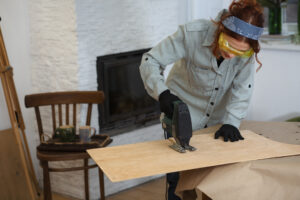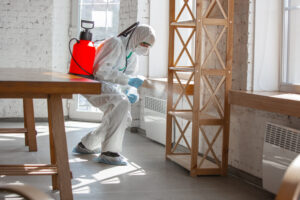Formaldehyde , a chemical compound commonly used in furniture manufacturing, is a potential threat to indoor air quality and overall health. Found in various adhesives, resins, and pressed wood products, formaldehyde is a significant contributor to indoor pollution in homes, offices, and schools. The risks of formaldehyde exposure are well-documented, with both short-term and long-term health consequences. In this article, we will dive deep into the risks of formaldehyde in built-in furniture and provide strategies for avoiding this hazardous chemical in your living environment.
, a chemical compound commonly used in furniture manufacturing, is a potential threat to indoor air quality and overall health. Found in various adhesives, resins, and pressed wood products, formaldehyde is a significant contributor to indoor pollution in homes, offices, and schools. The risks of formaldehyde exposure are well-documented, with both short-term and long-term health consequences. In this article, we will dive deep into the risks of formaldehyde in built-in furniture and provide strategies for avoiding this hazardous chemical in your living environment.
The Basics of Formaldehyde
 Formaldehyde is a volatile organic compound (VOC) that serves as a key ingredient in the production of resins and adhesives used to bind wood particles in various pressed wood products, such as plywood, particleboard, and medium-density fiberboard (MDF). These materials are widely used in the construction of built-in furniture, including cabinets, countertops, and storage units. While formaldehyde is an effective binding agent, it off-gases over time, meaning it gradually releases formaldehyde into the air, leading to potential health risks.
Formaldehyde is a volatile organic compound (VOC) that serves as a key ingredient in the production of resins and adhesives used to bind wood particles in various pressed wood products, such as plywood, particleboard, and medium-density fiberboard (MDF). These materials are widely used in the construction of built-in furniture, including cabinets, countertops, and storage units. While formaldehyde is an effective binding agent, it off-gases over time, meaning it gradually releases formaldehyde into the air, leading to potential health risks.
The risks of formaldehyde in furniture largely stem from its emissions. When formaldehyde is released into indoor air, it can reach harmful concentrations, especially in poorly ventilated spaces. Over time, even low levels of formaldehyde can negatively impact your health, making it critical to address its presence in your home.
Recognizing the Health Risks
Formaldehyde exposure presents a range of health risks, varying from minor irritations to more severe long-term complications. The risks of formaldehyde depend on several factors, including the concentration of formaldehyde in the air, the duration of exposure, and individual sensitivity.
Short-Term Health Effects
 In the short term, formaldehyde exposure can cause a variety of symptoms, including:
In the short term, formaldehyde exposure can cause a variety of symptoms, including:
- Eye, nose, and throat irritation
- Coughing, sneezing, and wheezing
- Skin rashes or allergic reactions
- Headaches and dizziness
These effects are more pronounced in spaces with high concentrations of formaldehyde or in individuals who are particularly sensitive to airborne chemicals, such as those with asthma or allergies.
Long-Term Health Risks
 Long-term exposure to formaldehyde is significantly more dangerous. Over time, chronic exposure can lead to:
Long-term exposure to formaldehyde is significantly more dangerous. Over time, chronic exposure can lead to:
- Asthma and other chronic respiratory problems
- Increased sensitivity to formaldehyde, meaning lower exposure levels may trigger symptoms
- Formaldehyde has been classified as a human carcinogen by several health organizations, including the International Agency for Research on Cancer (IARC). Long-term exposure increases the risk of developing certain cancers, such as nasopharyngeal cancer and leukemia.
The long-term risks of formaldehyde exposure highlight the importance of reducing this chemical in indoor environments, particularly where children, the elderly, or individuals with pre-existing health conditions are present.
How to Detect Formaldehyde in Furniture
Identifying formaldehyde in your home is the first step in reducing its impact. While it is difficult to detect without proper testing, there are several methods to gauge the presence of formaldehyde in built-in furniture.
1. Check Product Labels and Certifications
Many furniture manufacturers now produce items with low or no formaldehyde emissions. Look for labels that certify these products meet safety standards. These certifications indicate that the furniture has been tested and found to emit minimal amounts of formaldehyde.
2. Use Formaldehyde Testing Kits

Formaldehyde testing kits are available for home use and can provide a general idea of the levels present in your indoor environment. These kits usually involve placing a formaldehyde sensor in a room and sending it to a lab for analysis.
3. Hire a Professional for Indoor Air Quality Testing
For a more comprehensive assessment, you can hire a professional air quality inspector. They will use advanced equipment to measure formaldehyde and other VOC levels in your home and help pinpoint specific sources, such as built-in furniture.
Strategies for Avoiding Formaldehyde in Furniture
Once you are aware of the risks of formaldehyde, it’s important to take action to minimize exposure. Here are some effective strategies to reduce formaldehyde emissions from furniture.
1. Choose Formaldehyde-Free or Low-Emission Products
Opt for furniture made from formaldehyde-free materials like solid wood, metal, or glass. Pressed wood products often contain adhesives with formaldehyde, so look for certifications like GREENLABEL or CARB, which guarantee low-formaldehyde furniture. These certified options ensure that the furniture meets strict standards for minimizing harmful formaldehyde emissions, making your living environment safer and reducing exposure to harmful chemicals.
2. Ventilate Your Living Space
 Proper ventilation is crucial to lower formaldehyde levels in your home. Open windows and use fans to circulate air, especially when introducing new furniture. Air purifiers with activated carbon filters can also help reduce formaldehyde concentrations. Good airflow allows indoor pollutants to dissipate, minimizing the risks of formaldehyde exposure and improving overall indoor air quality.
Proper ventilation is crucial to lower formaldehyde levels in your home. Open windows and use fans to circulate air, especially when introducing new furniture. Air purifiers with activated carbon filters can also help reduce formaldehyde concentrations. Good airflow allows indoor pollutants to dissipate, minimizing the risks of formaldehyde exposure and improving overall indoor air quality.
3. Apply Sealants to Furniture
Applying a non-toxic sealant to furniture can reduce formaldehyde emissions by creating a protective barrier. Ensure the sealant is low in VOCs to avoid introducing additional chemicals. Use sealants on exposed surfaces of pressed wood furniture, such as particleboard, to limit off-gassing. This quick solution can minimize the release of harmful fumes, protecting your indoor air quality.
4. Use Older or Aged Furniture
 Older furniture typically emits less formaldehyde, as off-gassing decreases over time. Consider second-hand furniture or let new pieces off-gas in a ventilated area before bringing them indoors. Solid wood or aged furniture is safer since it releases fewer chemicals than newly manufactured items. This strategy reduces your exposure to harmful fumes and offers an eco-friendly alternative to new purchases.
Older furniture typically emits less formaldehyde, as off-gassing decreases over time. Consider second-hand furniture or let new pieces off-gas in a ventilated area before bringing them indoors. Solid wood or aged furniture is safer since it releases fewer chemicals than newly manufactured items. This strategy reduces your exposure to harmful fumes and offers an eco-friendly alternative to new purchases.
5. Prioritize Eco-Friendly Materials and Manufacturing
Choose furniture made from eco-friendly, natural materials like solid wood, bamboo, or recycled metal. These materials are less likely to contain formaldehyde-based resins. Look for certifications from organizations like the Forest Stewardship Council (FSC) or Sustainable Furnishings Council. These certifications ensure low-emission, sustainable furniture, reducing the risks of formaldehyde and supporting environmental responsibility.
Conclusion
The risks of formaldehyde in built-in furniture are a critical concern for anyone looking to create a safe, healthy home environment. From short-term irritations to serious long-term health risks like cancer, formaldehyde exposure can affect the well-being of everyone in the household. By learning how to detect formaldehyde and taking practical steps to reduce its presence, such as choosing low-emission materials and improving ventilation, you can minimize these risks and enjoy a healthier living space. Your health and safety are worth the effort in creating a home that is free from toxic chemicals like formaldehyde.
Ready to turn your healthier home dream into reality? Book an appointment with E³.SPACE, and let us bring your vision to life.

